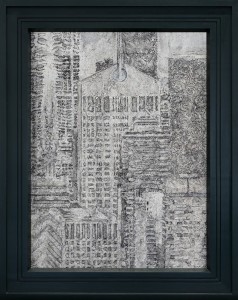ART CITIES:Rome-Richard Artschwager
 Richard Artschwager forged a unique path in art from the early 1950s through the early twenty-first century, making the visual comprehension of space and the everyday objects that occupy it strangely unfamiliar. His work has been variously described as Pop art, because of its derivation from utilitarian objects and incorporation of commercial and industrial materials; as Minimal art, because of its geometric forms and solid presence; and as conceptual art, because of its cool and cerebral detachment. But none of these classifications adequately define the aims of an artist who specialized in categorical confusion and worked to reveal the levels of deception involved in pictorial illusionism.
Richard Artschwager forged a unique path in art from the early 1950s through the early twenty-first century, making the visual comprehension of space and the everyday objects that occupy it strangely unfamiliar. His work has been variously described as Pop art, because of its derivation from utilitarian objects and incorporation of commercial and industrial materials; as Minimal art, because of its geometric forms and solid presence; and as conceptual art, because of its cool and cerebral detachment. But none of these classifications adequately define the aims of an artist who specialized in categorical confusion and worked to reveal the levels of deception involved in pictorial illusionism.
By Efi Michalarou
Photo: Gagosian Archive

The rare survey of the early decades of Richard Artschwager’s varied career, at Gagosian Gallery in Rome, demonstrates his ability to rearrange the structures of perception, bringing the deceptive pictorial world of images into direct confrontation with the concretely human world of objects. Through shifts in scale and transpositions of form and material, Artschwager’s artworks prompt an ongoing reassessment of space and time, suggesting compound narratives and compositional complexities, often at once quotidian and surreal. Employing synthetic, commercial, and industrial materials, Artschwager transformed his sources with a deadpan visual wit that makes the familiar strange. In 1962 he began working with Formica, a radically unconventional and “low” material, then most closely associated with the slippery surface of lunch counters. Its high-shine, typically marbled finish is both recognizable from everyday life and bears an abstract resemblance to expressionist painting. The early 1960s also marked the beginning of Artschwager’s experiments with Celotex, a heavily textured compound board made from compressed sugarcane fiber, which he used as a ground for his singular grisaille paintings, the waywardness of the industrial material blurring and obscuring his hand-drawn lines. These compositions were often based on subjects both arcane and mundane. Artschwager’s sculptural works demonstrate the ways in which he integrated artisanal skills into intellectual and formal experiments in perception and composition. In “Sliding Door” (1964), the door of a cabinet casts a shadow within the work’s pale interior, generating a constantly changing pattern that shifts along with light and the motion of the viewer around the object. “Untitled” (1965), made from Formica and wood, uses a circle’s curvature in the same way; while nonfunctional, it mimics the utilitarian aesthetic of an audio speaker or household appliance, demonstrating Artschwager’s ability to meet our expectations of an object or picture only to then subvert them.
Born in 1923 in Washington, DC, Richard Artschwager initially began studying at Cornell University in 1941, but World War II interrupted his studies. After sustaining a head wound, he spent most of the war on administrative duty in Frankfurt, Germany, and held a subsequent intelligence posting in Vienna, Austria. Upon returning to the United States, he completed his BA in 1948 in physics, but later moved to New York to follow his desire to work as an artist. He traveled to Paris, France, through the G.I. Bill to study under Amédée Ozenfant, after which he began designing and producing furniture to earn an income, which would greatly impact his later work in fine art. In the 1960s, he began experimenting with functional objects as well as painting and sculpture, and often worked with Formica to produce work that satisfied the requirements of different types of objects. Artschwager was commercially and critically successful during his lifetime, exhibiting at the major galleries of the moment including Leo Castelli in the 1960s and Mary Boone in the 1980s. He had multiple retrospectives at the Whitney Museum of American Art in New York, and major shows at the Centre Georges Pompidou, Paris, the Serpentine Gallery, London, and the Museum of the Applied Arts, Vienna, among many others. His works can be found in the permanent collections of major museums and collections around the world, including the MoMA, the Art Institute of Chicago, and the Foundation Cartier pour l’Art Contemporain.
Photo: Richard Artschwager, Double Color Study, 1965 Formica on wood, in 2 parts, each: 16 ⅛ × 13 ¾ × 4 ⅛ inches (41 × 35 × 10.5 cm), © 2020 Richard Artschwager/Artists Rights Society (ARS), New York. Photo: Roland Schmidt
Info: Gagosian Gallery, Via Francesco Crispi 16, Rome, Duration: 14/1-11/3/2021, Days & Hours: Tue-Sat 10:30-19:00, https://gagosian.com






